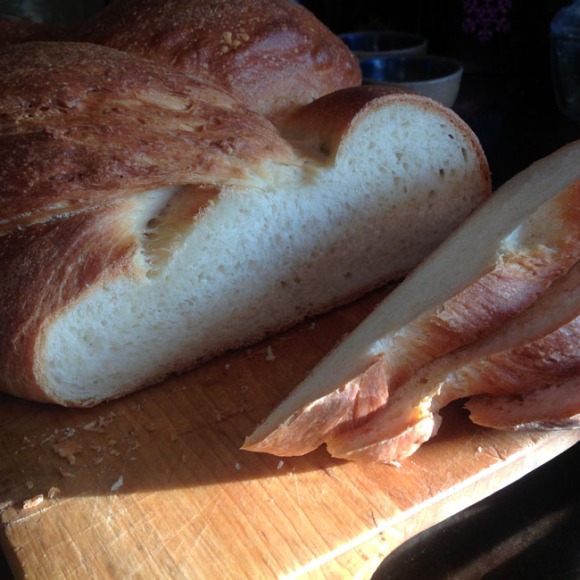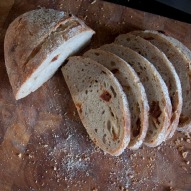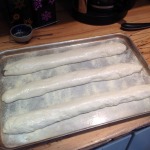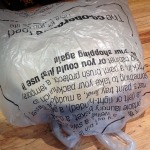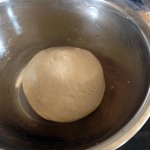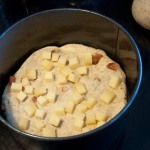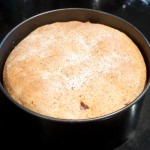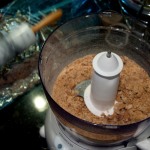Home-baked bread is the best, isn’t it? But there’s no way around the fact that it can be time consuming – by the time the dough has been mixed, kneaded, proved, shaped, proved again, and finally baked you’re at least two, if not three or four hours into the process. Flatbreads like Pitta, wraps, and pizza, can be made a bit faster, but the dough still needs to be mixed, kneaded, rested, and shaped before it’s baked or cooked in a skillet – so you’re still waiting an hour at least before lovely fresh bread can be yours.
At the moment, while many of us are at home under restrictions, time may not be such a challenge as it normally would be, but access to ingredients can be an issue. In various places, yeast seems to be a commodity in short supply. Fridge dough can help us here, too.

What if I told you you could have a batch of dough, in your refrigerator, ready to be baked into flatbreads within about half an hour, or risen dough loaves, rolls etc after simply shaping and an hour or so proving? And what if I told you that this was a batch that you could keep using again and again just by adding fresh flour, water, and a little pinch of salt and sugar. Sounds like magic, right?
In a way, it is – it’s the magic that has kept traditional bakeries going for centuries, long before standardised, fresh and dry commercial yeast became the usual technology for baking loaves. It’s not *quite* a magic bullet for yeast shortages – you will need a dose of yeast to start it, and you may need to top up with fresh yeast from time to time (because of a process called attenuation that I’ll come back to), but by using this technique you should be able to have almost ready-to-bake dough ready to be used at the drop of a hat, and stretch a single spoon-full of dried yeast to bake batch after batch of lovely fresh bread, which is great if you’re trying to eke-out limited supplies.
I’m sold, how does this work?
You start by making a batch of normal yeasted bread dough. Mine is made from a mix of 75% strong white and 25% wholemeal flour, because it gives a lovely flavour and texture while retaining the nice soft character of white bread, but use whatever you prefer.
Start your batch with:
- 500g strong bread flour (75% strong white, 25% strong wholemeal)
- 1tsp dried instant yeast
- 1tsp salt
- 1tsp sugar
- Progressively add cool water to make a well hydrated, elastic dough.
Kneed by hand or in a mixer with a dough hook, with a little oil (I use cold-pressed rapeseed oil, but a nice light-flavoured olive oil would be fine), for 5-10 minutes until the dough is soft, pliable and elastic.
Oil the inside of a bowl, or Tupperware-type container (a size about 3-4 times the volume of kneaded dough is ideal), pop the oiled dough into this, cover with a lid or cling film (don’t seal it completely as you need to allow gas to escape as the yeast works) and pop it in the refrigerator at least overnight.

When you come to use the dough:
- Take the dough from the fridge, turn it out onto a clean, oiled worktop, divide the batch in two.
- Set half aside to bake with, and put half into a bowl or mixer, and add:
- 250g strong bread flour (mix as above)
- Pinch of salt
- Pinch of sugar
- Mix, adding enough cool water to make a well hydrated, elastic dough
- Kneed, oil, and return to the refrigerator. You need to be baking with and refreshing the dough at least every 2-3 days to keep it healthy and in good condition.
Now, you can bake the other half of the batch. The technique for pittas is here – you should be eating them within 30 minutes – but really anything you can think of will probably work, just experiment! The recipe and process for soughdough pizza should be equally applicable to your fridge dough. I will add to the tested techniques in a future blog post.
But my yeast is out of date and a bit rubbish, will this still work?
The key here is to really get the yeast going before you make the first batch, so I would modify the process like this:
Activate your yeast in some warm water with a bit of sugar, waiting until it really froths up nicely before making the dough. Then, rather than putting the dough straight in the fridge, I would allow it a full proving cycle at room temperature, so that the dough at least doubles in size, I would then take half the dough out and bake with it straight away, add fresh flour, water, salt and sugar as above, and only then pop it in the fridge. Hopefully your yeast will be strong and healthy and present in sufficient quantity by this stage.
It worked, to start with, but it’s been in the fridge a couple of weeks now, and despite baking and refreshing regularly it’s just not rising properly any more. My loaves / rolls are turning out heavy and stodgy. What’s going wrong?
You’ve almost certainly run into a problem with yeast attenuation. Without getting unnecessarily nerdy about this, your fridge dough is a live yeast culture. Yeast is a highly adaptable little blighter which gets through generations fast, and the culture you are maintaining in your dough can quickly change its growth characteristics to adapt to the circumstances it finds itself in. For nice soft puffy risen loaves and rolls, you want a yeast that expands its population rapidly at room temperature when its nutritional needs are met (that’s to say, once you shape the dough and leave it to prove before baking). Keeping the dough in the fridge, convenient as it is, in in effect selecting for yeast strains that are happier working and dividing more steadily at colder temperatures. This is less important if you want to use the dough for flatbreads, pizza bases and so on, as you’re not asking the yeast to put on that final ‘push’ of multiplication before baking, but if you want to use the dough to bake loaves and rolls too, it can be an issue.
One option is to add an extra spoon of new yeast next time you add fresh flour to the mix. You’ll probably find topping up every four or five times keeps things ticking over reasonably crisply, and you’ll still be reducing your fresh yeast use by a significant margin.
Another option worth experimenting with is giving the dough a room temperature proving step every few uses (as described above with older yeast) as this might tune the behaviour of the yeast culture more towards the one we want.
If all else fails, bake up a big batch of pizza or pittas with the dough you have, and start over!
More from the Fallback Pantry :: More from the Country Skills Blog >>










